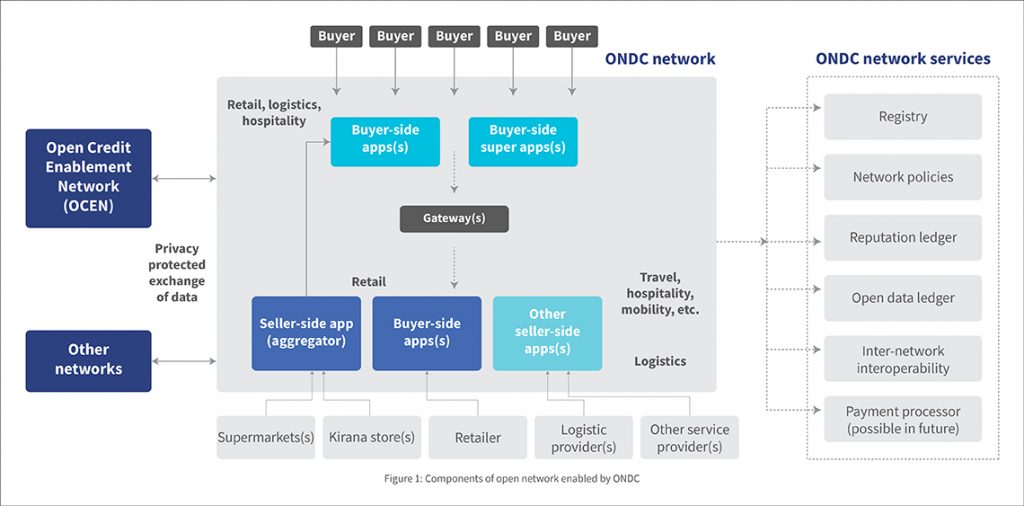Open Network for Digital Commerce (ONDC): Yet another buzzword or a bridge to inclusive and universal market access?
by Mitali, Shweta Menon and Akshat Pathak
Oct 5, 2023
6 min
India has more than 63.39 million micro, small, and medium enterprises (MSMEs), which employ 111 million people and cumulatively contribute 30.27% to the GDP. Yet these MSMEs face two related but significant challenges—access to capital and market. Open Network for Digital Commerce (ONDC) is an initiative to promote open networks for the exchange of goods and services over digital or electronic networks nationwide. Our blog talks about the crucial role ONDC could play to unlock lending opportunities for MSMEs and improve their access to online marketplaces.
Sana is a clothes wholesaler from Uttar Pradesh in northern India. During the COVID-19 pandemic and the subsequent lockdowns, she took the leap to digital and registered her business on a B2B platform. Savitri, another clothes retailer from Maharashtra in western India, seeks an alternate supplier as she is unhappy with the cloth quality and designs offered by local wholesalers. In the current scenario, Savitri and Sana can only discover each other online if they register on the same application or platform. However, with the Open Network for Digital Commerce (ONDC), they could connect, even if they do not register on the same app or platform.
India has more than 63.39 million micro, small, and medium enterprises (MSMEs), which contribute 30.27% to the GDP and employ 111 million people. Yet these MSMEs face two related but significant challenges—access to capital and market. The overall credit gap in the MSME sector is estimated at INR 25 trillion (~USD 304 billion). In contrast, MSMEs’ overall debt demand in India is INR 69.3 trillion (~USD 843.19 billion), which continues to grow at 11.5% CAGR.
Women-led businesses (WLBs) comprise 20.37% of MSMEs in India. They are more vulnerable to these challenges. Many WLBs, such as those led by Sana and Savitri, have low awareness of business registration. They have limited digital literacy, which affects how well they can manage multiple selling apps and social biases. Around 90% of MSMEs in the country still operate offline, and 99% are microenterprises. Digital platforms or networks, such as ONDC, are emerging as a critical avenue to empower MSMEs, especially WLBs. These platforms have immense potential to foster innovation, increase sales through better reach, and reduce market risks.
What is ONDC?
ONDC is an initiative to promote open networks for the exchange of goods and services over digital or electronic networks at a national scale. It enables sellers and buyers to be digitally visible and transact through an open network, regardless of the platform or application they use. It serves as a neutral platform to set protocols for cataloging, vendor matching, and price discovery on an open-source basis. Figure 1 showcases how the components of the open network enabled by ONDC interact with other networks:
Figure 1: Components of open network enabled by ONDC
In Figure 1, the ONDC network (at the center) comprises network participants, which join ONDC as a buyer-side app, seller-side app, or gateway to form the open network. ONDC network services (on the right) show the common services that enable network participants to transact on the network and create the digital infrastructure ONDC offers. Other networks (on the left) show open networks in other domains with which it can seamlessly interface, for example, the Open Credit Enablement Network (OCEN).
ONDC intends to replace the present platform-centric e-commerce model with an open-network approach. It is neither a super aggregator app nor a hosting platform. It only enables the discovery of location-aware, local digital commerce stores across industries and engagement with them by any network-enabled applications. It eliminates the need for buyers and sellers to register on common apps or platforms. This is possible through open communication protocols.
All digital commerce apps and platforms can voluntarily adopt and join the ONDC network. The network-enabled applications will continue to onboard sellers and buyers and manage end-to-end orders. As a result, e-commerce will be more accessible to all shoppers and vendors, which brings us to the next question.
How will ONDC help WLBs?
It enhances their discovery: When Sana decided to go digital, she had two choices—she could build her own digital space through an app or a website or list her products on marketplaces or aggregators. Yet an app or a website would cost a lot of time and effort. It would also impose limitations, such as policies, commissions, and brand preferences.
Figure 2: Potential of ONDC
MSC’s experience with WLBs in India suggests that most businesses struggle to scale through e-commerce, even though they have a smartphone and access to the internet. WLBs do not register their businesses online. This restricts their chances to sell on online marketplaces. Only 18% of WLBs have registered on the Udyam portal. They also hesitate to explore digital platforms as they believe their business is too small to enter the digital space. The considerable listing fee on e-commerce platforms and heavy documentation processes further dissuade them from going online.
ONDC has already onboarded prominent apps on the seller side, such as Meesho, Paytm Mall, and CoutLoot. Paytm alone acts as a digital storefront for more than 8 million small merchants. The merchants registered on these seller apps automatically get signed up on ONDC. However, offline merchants are also being encouraged to sign up.
The details around onboarding support and grievance resolution mechanism (GRM) are yet to be clarified by the ONDC officials. Yet ONDC has immense potential to onboard small merchants, such as Savitri and Sana, particularly if we consider the multiplier effects. It offers wide discoverability for small businesses and vast opportunities to expand into neighboring areas. Currently, ONDC does not charge any platform fee, but it might set a transaction fee of 1.5% later—a much lower sum than which e-commerce giants and aggregator platforms charge.
It improves access to finance: Despite a 75% increase in their numbers, WLBs’ share of the MSMEs’ annual turnover is a mere 20%. MSC’s reports and our work with WLBs, such as the SEWA Cooperative Federation, indicate that women-led businesses struggle with access to capital more than their male counterparts as they lack ownership of collaterals and legal documents to secure formal credit. Social norms exacerbate the situation and increase their reliance on informal credit sources.
Alternative financing, which otherwise has immense potential to bridge the credit gap, does not work for most small businesses, especially WLBs, as they lack digital footprints. The ONDC platform provides an immense opportunity to bridge the credit gap of WLBs, currently worth USD 158 billion. The platform can help generate digital footprints for small businesses through point-of-sale (PoS) data. Players in the alternative financing space can then assess creditworthiness through PoS data and offer WLBs small-ticket, customized credit.
It opens landscapes of opportunity: MSMEs, especially WLBs, struggle to meet changes in customer preferences and market trends due to a lack of customized training and skill development programs. ONDC can connect millions of WLBs to promote peer learning. The backend data and interaction with WLBs can serve as a powerful source to design and customize capacity-building programs. These programs can help bridge the skill gap and help millions of WLBs expand their business and sales.
ONDC’s story so far
Currently, e-commerce channels serve only 8-10% of the value market. ONDC can potentially increase this share to 22% by 2026. In April 2022, ONDC started its alpha testing phase with a closed user group of buyers in Bengaluru. By September 2022, it had expanded to more than 80 cities. The platform validated the apps in this phase and confirmed business and operational flows. Now in its beta testing phase, the general public can experience shopping on the interoperable platform and provide feedback.
Over the next five years, ONDC intends to onboard 900 million buyers and 1.2 million sellers and reach a gross merchandise value of USD 48 billion. Moreover, around 63.39 million MSMEs and 12 million kiranas, South Asia’s hyperlocal neighborhood provision stores, can scale their operations through digital commerce.
But first, the ONDC model must overcome issues related to platform iterations and general awareness among the users to achieve this. It should also consider the possibility of commercial mismatch, especially for kiranas. These small stores operate on thin margins (5%-20%) and cannot afford to pay a 3% cut to the apps that onboarded them and another 2-3% to those who facilitate payments and bear logistics costs. Lastly, the model must account for open competition based on price discounts between large and small sellers, as larger sellers can afford to offer heavy discounts to customers due to economies of scale.
Yet despite challenges, the open network holds vast potential. It can curb digital monopolies and transform India’s e-commerce sector to a more platform-agnostic model. In the days to come, ONDC could generate inclusive growth and bring millions of micro-merchants, much like Sana and Savitri, into the folds of the digital commerce revolution and fuel their growth, dreams, and aspirations.
 by
by  Oct 5, 2023
Oct 5, 2023 6 min
6 min 





Leave comments